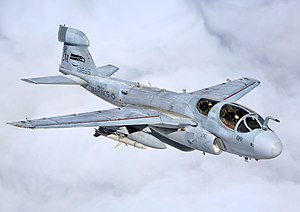
Back نورثروب غرومان إي إيه-6 بي براولر Arabic Grumman EA-6B Prowler Catalan Northrop Grumman EA-6B Prowler Czech Northrop Grumman EA-6B Prowler Danish Grumman EA-6 German Grumman EA-6B Prowler Spanish نورثروپ گرومن ئیای-۶بی پراولر Persian Grumman EA-6B Prowler Finnish Grumman EA-6 Prowler French EA–6B Prowler Hungarian
| EA-6B Prowler | |
|---|---|
 Grumman EA-6B Prowler in flight | |
| General information | |
| Type | Electronic warfare/Attack aircraft |
| Manufacturer | Grumman Northrop Grumman |
| Status | Retired[1] |
| Primary users | United States Navy (historical) United States Marine Corps (historical) |
| Number built | 170[2] |
| History | |
| Manufactured | 1966-1991 |
| Introduction date | July 1971 |
| First flight | 25 May 1968[3] |
| Retired | 2015 (USN) March 2019 (USMC) |
| Developed from | Grumman A-6 Intruder |
The Northrop Grumman (formerly Grumman) EA-6B Prowler is a twin-engine, four-seat, mid-wing electronic-warfare aircraft. Operated by both the United States Marine Corps and United States Navy between 1971 and 2019, it was derived from the A-6 Intruder airframe.
The aircraft's immediate predecessor, the EA-6A, was an interim conversion of the A-6 airframe to perform electronic warfare missions during the 1960s. In 1966, work on the more advanced EA-6B commenced. It featured an enlarged four-seat cockpit, a fully integrated electronic warfare system, and advanced electronic countermeasures. Furthermore, it was suitable for long-range, all-weather carrier-based operations in addition to land-based uses. Typically, the aircrew of an EA-6B consisted of a single pilot and three Electronic Countermeasures Officers,[4] though it was not uncommon for only two ECMOs to be used on missions. It was capable of firing anti-radiation missiles (ARMs), such as the AGM-88 HARM.[5] Although designed as an electronic warfare and command-and-control aircraft for air strike missions, the EA-6B was also capable of attacking some surface targets on its own, in particular enemy radar sites and surface-to-air missile launchers. In addition, the EA-6B was capable of gathering electronic signals intelligence.
On 25 May 1968, the EA-6B performed its maiden flight; a total of three prototype were converted from A-6As while five EA-6Bs participated in the development programme. During July 1971, Tactical Electronic Warfare Squadron 132 (VAQ-132) became the first operational squadron to be equipped with the type; the EA-6B's first combat deployment took place 11 months later in the latter half of the Vietnam War. It frequently carried out electronic warfare operations, such as the jamming of enemy radar systems, as well as the gathering of radio intelligence on enemy radar and air defense systems. The EA-6B would also play an active role during the 1983 invasion of Grenada, Operation El Dorado Canyon (1986 Libya), Operation Praying Mantis (Iran 1988), and Operation Desert Storm (Iraq 1991). It would also be called on during the Operation Enduring Freedom (Afghanistan 2001–2014) and Operation Inherent Resolve (Iraq 2014) in addition to other lower intensity duties.
By the twenty-first century, efforts to eventually replace the EA-6B had been launched, such as the abortive Common Support Aircraft initiative. As a result of the type being heavily used during its lengthy service life, the EA-6B had become a relatively high-maintenance aircraft during its latter years of service. Nevertheless, it had undergone frequent equipment upgrades throughout its service life;[2] major programmes included the Advanced Capability EA-6B and the Improved Capability (ICAP) II schemes. The type's final overseas deployment occurred in late 2014; the EA-6B was withdrawn from U.S. Navy service in June 2015 while the U.S. Marine Corps retired its last aircraft in March 2019. It has been effectively succeeded by the EA-18G Growler, an electronic warfare derivative of the F/A-18F Super Hornet.
- ^ "VMAQ-2 – 44 Years of Electronic Warfare". marines.mil. 11 January 2019.
- ^ a b Hansen 2006, p. 8.
- ^ "EA-6B Prowler". Warfighters Encyclopedia. Naval Air Systems Command. Archived from the original on 5 November 2004.
- ^ Bolkcom, Christopher (3 December 2001). Electronic Warfare: EA-6B Aircraft Modernization and Related Issues for Congress (Report). Library of Congress, Congressional Research Service. p. 4. Archived from the original on 6 February 2024.